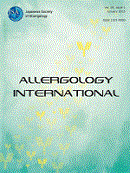53 巻, 3 号
選択された号の論文の12件中1~12を表示しています
- |<
- <
- 1
- >
- >|
REVIEW ARTICLE
-
2004 年 53 巻 3 号 p. 199-203
発行日: 2004年
公開日: 2006/01/19
PDF形式でダウンロード (174K) -
2004 年 53 巻 3 号 p. 205-209
発行日: 2004年
公開日: 2006/01/19
PDF形式でダウンロード (580K) -
2004 年 53 巻 3 号 p. 211-217
発行日: 2004年
公開日: 2006/01/19
PDF形式でダウンロード (156K) -
2004 年 53 巻 3 号 p. 219-226
発行日: 2004年
公開日: 2006/01/19
PDF形式でダウンロード (421K) -
2004 年 53 巻 3 号 p. 227-233
発行日: 2004年
公開日: 2006/01/19
PDF形式でダウンロード (556K)
ORIGINAL ARTICLE
-
2004 年 53 巻 3 号 p. 235-240
発行日: 2004年
公開日: 2006/01/19
PDF形式でダウンロード (64K) -
2004 年 53 巻 3 号 p. 241-244
発行日: 2004年
公開日: 2006/01/19
PDF形式でダウンロード (55K) -
2004 年 53 巻 3 号 p. 245-254
発行日: 2004年
公開日: 2006/01/19
PDF形式でダウンロード (774K) -
2004 年 53 巻 3 号 p. 255-264
発行日: 2004年
公開日: 2006/01/19
PDF形式でダウンロード (486K) -
2004 年 53 巻 3 号 p. 265-269
発行日: 2004年
公開日: 2006/01/19
PDF形式でダウンロード (164K) -
2004 年 53 巻 3 号 p. 271-278
発行日: 2004年
公開日: 2006/01/19
PDF形式でダウンロード (380K) -
2004 年 53 巻 3 号 p. 279-285
発行日: 2004年
公開日: 2006/01/19
PDF形式でダウンロード (903K)
- |<
- <
- 1
- >
- >|
